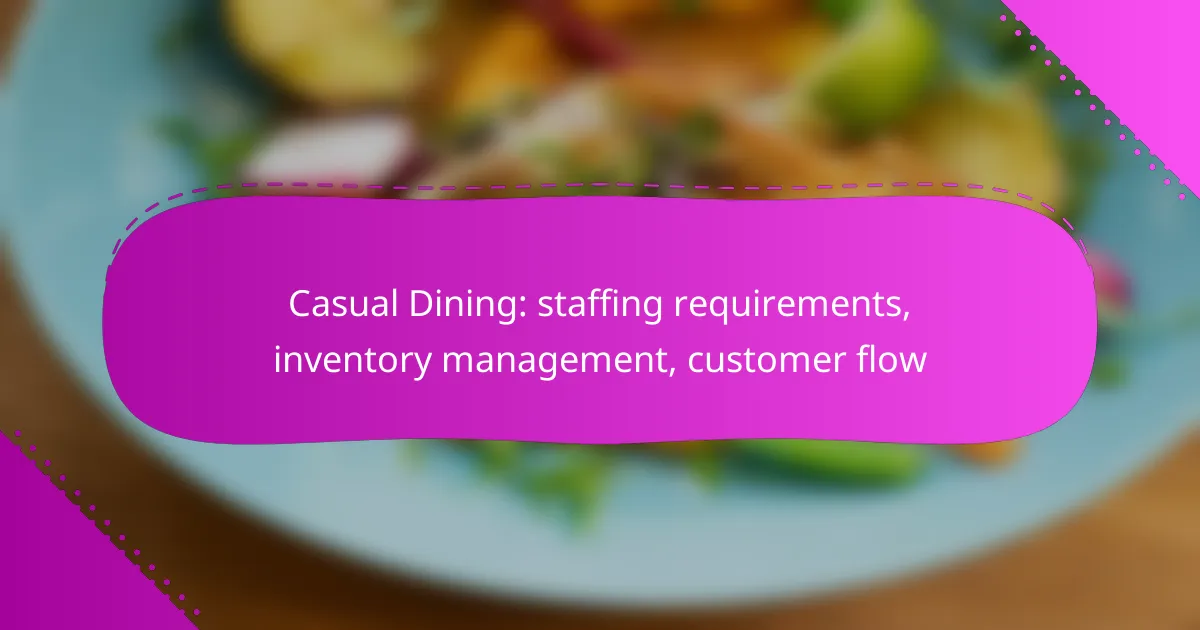Casual dining establishments require careful consideration of staffing needs, balancing front-of-house and back-of-house roles to ensure smooth operations. Effective inventory management is crucial for meeting customer demand while minimizing waste and costs, necessitating a systematic approach and strong supplier relationships. Additionally, optimizing customer flow through strategic seating arrangements and efficient staff training can significantly enhance the dining experience and satisfaction levels.

What are the staffing requirements for casual dining in Canada?
Staffing requirements for casual dining in Canada typically include a mix of front-of-house and back-of-house roles, along with management positions. The number of staff needed can vary based on the restaurant’s size, menu complexity, and customer volume.
Front-of-house staffing needs
Front-of-house staffing in casual dining includes servers, hosts, and bartenders. A general guideline is one server for every four to six tables, depending on the restaurant’s service style and peak hours.
Hosts are essential for managing customer flow, greeting guests, and handling reservations. Depending on the size of the establishment, one to two hosts may be sufficient during busy times.
Back-of-house staffing needs
Back-of-house staffing typically involves cooks, dishwashers, and kitchen managers. A common structure includes one head chef, several line cooks, and at least one dishwasher for every few cooks to maintain efficiency.
The number of cooks can vary based on the menu complexity; for instance, a restaurant with a diverse menu may require more specialized chefs, while simpler menus can operate with fewer staff.
Management roles
Management roles in casual dining often include a general manager, assistant managers, and shift supervisors. The general manager oversees operations, while assistant managers handle specific areas like front-of-house or back-of-house.
Having a clear hierarchy helps streamline decision-making and ensures that staff are supported during busy periods. It’s common to have one manager for every 20 to 30 employees to maintain effective oversight.
Seasonal staffing considerations
Seasonal staffing is crucial for casual dining establishments that experience fluctuations in customer volume, particularly during holidays or summer months. Many restaurants hire temporary staff to accommodate increased demand, which can include part-time servers and seasonal cooks.
Planning ahead for seasonal staffing involves forecasting customer flow and adjusting schedules accordingly. It’s advisable to start recruiting seasonal staff a few weeks before peak periods to ensure adequate training and integration into the team.

How to manage inventory effectively in casual dining?
Effective inventory management in casual dining involves maintaining the right stock levels to meet customer demand while minimizing waste and costs. This requires a systematic approach to tracking inventory, leveraging technology, and fostering strong supplier relationships.
Best practices for inventory tracking
Implementing best practices for inventory tracking is crucial for casual dining establishments. Regularly conduct physical counts to verify stock levels and reconcile them with your records. Establish a consistent schedule for these counts, such as weekly or bi-weekly, depending on your volume of sales.
Utilize a first-in, first-out (FIFO) method to ensure older stock is used before newer items, reducing spoilage. Additionally, categorize inventory into fast-moving, slow-moving, and non-moving items to prioritize management efforts and optimize ordering processes.
Technology solutions for inventory management
Technology can significantly enhance inventory management in casual dining. Point of Sale (POS) systems integrated with inventory management software can automate stock tracking and provide real-time data on sales trends. This helps in making informed decisions about reordering and menu adjustments.
Consider using mobile inventory management apps that allow staff to update stock levels on-the-go, improving accuracy and efficiency. Many of these solutions offer features like alerts for low stock levels and analytics to forecast demand, which can be invaluable for planning.
Supplier relationships and ordering
Building strong relationships with suppliers is essential for effective inventory management. Regular communication can lead to better pricing, priority during shortages, and more flexible ordering terms. Establish a routine for evaluating supplier performance based on quality, reliability, and cost.
When placing orders, consider using a just-in-time (JIT) approach to minimize excess inventory while ensuring you have enough stock to meet demand. This strategy requires close monitoring of sales patterns and timely communication with suppliers to adjust orders as needed.

What strategies improve customer flow in casual dining?
Improving customer flow in casual dining involves optimizing seating arrangements, implementing effective reservation systems, and training staff for efficiency. These strategies help manage the dining experience, reduce wait times, and enhance customer satisfaction.
Seating arrangements and layout
Effective seating arrangements can significantly influence customer flow. Consider using a mix of table sizes to accommodate different group sizes, allowing for flexibility in seating. Arranging tables to create clear pathways can also facilitate movement, reducing congestion during peak hours.
Additionally, utilizing outdoor seating when possible can increase capacity and improve the overall dining experience. Ensure that the layout complies with local safety regulations, providing enough space for patrons and staff to navigate comfortably.
Reservation systems
Implementing a reservation system can streamline customer flow by managing expected traffic. Systems that allow customers to book tables in advance help reduce wait times and provide a better estimate of peak hours. Consider using online platforms that integrate with your existing systems for ease of use.
Offering incentives for off-peak reservations, such as discounts or special menu items, can encourage customers to dine during less busy times, further balancing the flow throughout the day.
Staff training for efficiency
Training staff to work efficiently is crucial for maintaining smooth customer flow. Focus on teaching staff how to manage multiple tables effectively, prioritize tasks, and communicate clearly with the kitchen. Regular training sessions can help reinforce these skills and adapt to any changes in menu or service style.
Encourage teamwork among staff members to ensure that all areas of the restaurant are covered during busy times. Implementing a buddy system can help new employees learn from experienced staff, enhancing overall service quality and efficiency.

What are the key performance indicators for staffing and inventory?
The key performance indicators (KPIs) for staffing and inventory in casual dining include staff turnover rates and inventory turnover ratios. These metrics help assess operational efficiency and customer satisfaction while guiding management decisions.
Staff turnover rates
Staff turnover rates measure the percentage of employees who leave a restaurant within a specific period, typically annually. High turnover can indicate issues such as poor management, inadequate training, or low employee morale, which can negatively impact service quality and customer experience.
To manage turnover effectively, aim for a rate below 30% in casual dining. Strategies include offering competitive wages, fostering a positive work environment, and providing opportunities for career advancement. Regular feedback and recognition can also enhance employee retention.
Inventory turnover ratios
Inventory turnover ratios indicate how often a restaurant sells and replaces its inventory within a given timeframe. A higher ratio suggests efficient inventory management, while a lower ratio may signal overstocking or slow sales. For casual dining, a turnover ratio of 5 to 10 times per year is generally considered healthy.
To improve inventory turnover, monitor sales trends and adjust orders accordingly. Implementing a first-in, first-out (FIFO) system can help reduce waste and ensure freshness. Regular audits and inventory tracking software can also enhance visibility and control over stock levels.

How does customer flow impact staffing needs?
Customer flow significantly influences staffing requirements in casual dining establishments. High customer traffic during peak times necessitates more staff to ensure efficient service and maintain a positive dining experience.
Peak hours staffing adjustments
During peak hours, such as lunch and dinner times, restaurants should increase their staffing levels to accommodate the influx of customers. This often means scheduling additional servers, kitchen staff, and hosts to manage the higher volume effectively.
A common approach is to analyze historical data to identify peak times and adjust staffing accordingly. For example, if a restaurant typically sees a surge of customers between 6 PM and 8 PM, it may be beneficial to schedule 20-30% more staff during those hours.
Impact of customer flow on service quality
The flow of customers directly affects service quality, as an overwhelmed staff can lead to longer wait times and decreased customer satisfaction. When customer flow is high, ensuring that staff are adequately trained and prepared to handle busy periods is crucial.
To maintain service quality, restaurants should implement strategies such as cross-training employees to perform multiple roles and utilizing technology for order management. Regularly assessing customer feedback can also help identify service bottlenecks and areas for improvement, ensuring a consistently positive dining experience.

What are the emerging trends in casual dining staffing and inventory?
Emerging trends in casual dining staffing and inventory management focus on leveraging technology to enhance efficiency and reduce costs. Key developments include the integration of artificial intelligence in staffing solutions and the adoption of automation for inventory management.
Use of AI in staffing solutions
AI is transforming staffing in casual dining by predicting labor needs based on historical data and customer flow patterns. This technology can analyze peak hours, seasonal trends, and special events to optimize staff schedules, ensuring that restaurants are neither overstaffed nor understaffed.
Restaurants can also utilize AI-driven platforms for recruitment, streamlining the hiring process by matching candidates’ skills with job requirements. This reduces time spent on interviews and improves the quality of hires, which is crucial in a competitive labor market.
Automation in inventory management
Automation in inventory management helps casual dining establishments maintain optimal stock levels while minimizing waste. Automated systems can track inventory in real-time, alerting managers when supplies are low or when items are nearing expiration.
Implementing such systems can lead to significant cost savings. For example, restaurants can reduce food waste by up to 30% through better inventory tracking and forecasting. Additionally, automated ordering systems can streamline the purchasing process, ensuring that restaurants always have the necessary ingredients on hand without overstocking.
